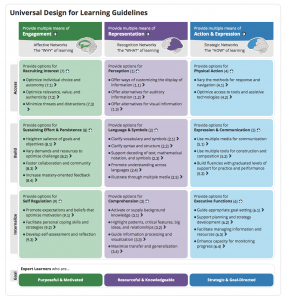About Universal Design for Learning (UDL)
Universal design for learning (UDL) is a framework for designing educational materials and environments that are accessible and usable by all learners, regardless of their abilities or disabilities (CAST, 2018). In higher education, UDL can be a powerful tool for faculty to create more inclusive and engaging learning experiences for their students.
One of the key principles of UDL is the idea that learners have different needs and preferences, and that educational materials and environments should be designed to support these differences (CAST, 2018). This means providing multiple ways of representing information, multiple ways of interacting with content, and multiple ways of expressing understanding (CAST, 2018).
For example, a faculty member teaching a history course could provide a variety of reading materials, such as text, audio, and video, to allow students to choose the format that works best for them (CAST, 2018). They could also incorporate different types of activities, such as discussions, simulations, and hands-on projects, to allow students to engage with the material in different ways (CAST, 2018).
Another important aspect of UDL is the emphasis on providing learners with choices and control over their learning experiences (CAST, 2018). This can involve giving students options for how they learn, how they demonstrate their knowledge, and how they receive feedback (CAST, 2018). For instance, a faculty member could offer multiple assessment methods, such as exams, papers, and presentations, and allow students to choose the method that they feel most comfortable with (CAST, 2018).
UDL also involves ongoing assessment and evaluation of the learning environment, to ensure that it is meeting the needs of all learners (CAST, 2018). This can involve using data and feedback from students to identify areas for improvement, and making changes to the materials and activities to better support the diverse needs of the class (CAST, 2018).
Overall, universal design for learning offers higher education faculty a powerful set of principles and strategies for creating more inclusive and engaging learning environments for their students (CAST, 2018). By providing multiple ways of representing information, multiple ways of interacting with content, and multiple ways of expressing understanding, faculty can create learning experiences that are accessible and usable by all learners (CAST, 2018).
The goal
The goal of UDL is to support “expert learners who are, each in their own way, purposeful and motivated, resourceful and knowledgeable, and strategic and goal driven.”
Principles – guidelines and checkpoints
- Multiple means of engagement
- Multiple means of representation
- Multiple means of action and expression
Resources
References
CAST (2018). Universal Design for Learning Guidelines version 2.2. Retrieved from http://udlguidelines.cast.org

